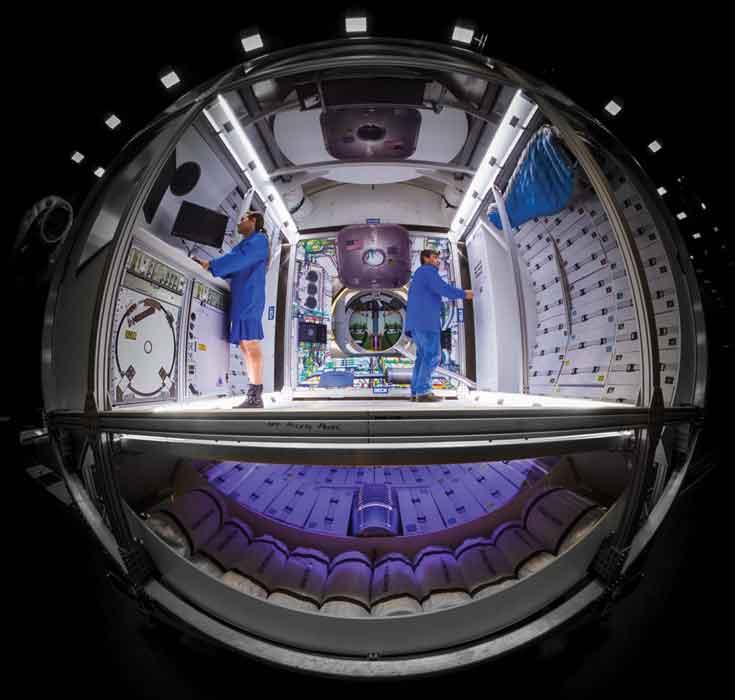- FMA
- The Fabricator
- FABTECH
- Canadian Metalworking
Categories
- Additive Manufacturing
- Aluminum Welding
- Arc Welding
- Assembly and Joining
- Automation and Robotics
- Bending and Forming
- Consumables
- Cutting and Weld Prep
- Electric Vehicles
- En Español
- Finishing
- Hydroforming
- Laser Cutting
- Laser Welding
- Machining
- Manufacturing Software
- Materials Handling
- Metals/Materials
- Oxyfuel Cutting
- Plasma Cutting
- Power Tools
- Punching and Other Holemaking
- Roll Forming
- Safety
- Sawing
- Shearing
- Shop Management
- Testing and Measuring
- Tube and Pipe Fabrication
- Tube and Pipe Production
- Waterjet Cutting
Industry Directory
Webcasts
Podcasts
FAB 40
Advertise
Subscribe
Account Login
Search
Custom sheet metal parts solve storage space limitations in outer space
- December 3, 2019
- News Release
- Shop Management
Situation
Five decades after mankind first set foot on the moon, NASA is developing the Orion spaceship, which will launch astronauts back into lunar orbit, to the moon’s surface, and, if all goes as scheduled, to Mars.
Lockheed Martin, a major NASA contractor, is designing parts of the infrastructure that will support NASA’s Gateway, a space port that will orbit the moon. In a Florida building, the company is constructing an earthbound, full-sized physical model of the living quarters portion of the Gateway, called the Habitat Ground Test Article (HGTA). The space-based version of this module will provide a comfortable environment for astronauts on their long journeys and currently is scheduled to launch in 2024. It will dock with another module that will generate power and propulsion, which will launch in 2022.
Not surprisingly, to accommodate astronauts traveling through the vastness of space, Lockheed Martin has to consider small but critical details—like storage—as carefully as big ones.
Resolution
For sheet metal fabrication for the HGTA’s storage modules, the aerospace company decided to work with Protolabs; the companies have partnered before, including producing prototype parts for a portable drone.
Jeff Budny, a Lockheed Martin systems integration engineer, visited Protolabs’ Nashua, N.H., facility to ensure that the company’s sheet metal fabrication capabilities were up to the task, and the build began soon thereafter.
Protolabs’ framework had to be lightweight to maximize fuel efficiency but also strong enough to hold heavy objects in place and survive the jostling that is inherent during a rocket launch. Cargo and experiments can’t tumble down from a storage rack midflight, so the system needed to be able to maintain its integrity when confronted with excessive g-forces. Lightweight but strong aluminum proved the best material for this project.
“The parts that Protolabs created for this project will have to last for an entire generation—the lifetime of the project,” said Chris Cloutier, Lockheed Martin’s Advanced Programs prototype lead. “That means modularity is especially important so we can adapt the structure to meet tomorrow’s needs.” The storage area Lockheed Martin and Protolabs created can easily change configurations to accommodate today’s experiments or whatever might be needed in the future.
Safety also was taken into consideration, as an injury 200,000 miles from Earth can result in tragedy. To that end, Protolabs used techniques such as chamfering to craft parts carefully and eliminate sharp edges.
Some parts also have complex bends, which Protolabs manufactured to tight specifications. When completed, the parts were shipped to Florida for what Cloutier referred to as “easy assembly.”
The parts for this next-generation space mission now are installed in the HGTA, and Lockheed Martin’s designs are entering a test phase. NASA astronauts will soon experience the HGTA environment for themselves and help determine if the model meets their needs and expectations. As part of the testing, they will be looking closely at the storage modules that Protolabs fabricated.
subscribe now

The Fabricator is North America's leading magazine for the metal forming and fabricating industry. The magazine delivers the news, technical articles, and case histories that enable fabricators to do their jobs more efficiently. The Fabricator has served the industry since 1970.
start your free subscription- Stay connected from anywhere

Easily access valuable industry resources now with full access to the digital edition of The Fabricator.

Easily access valuable industry resources now with full access to the digital edition of The Welder.

Easily access valuable industry resources now with full access to the digital edition of The Tube and Pipe Journal.
- Podcasting
- Podcast:
- The Fabricator Podcast
- Published:
- 04/30/2024
- Running Time:
- 53:00
Seth Feldman of Iowa-based Wertzbaugher Services joins The Fabricator Podcast to offer his take as a Gen Zer...
- Industry Events
Pipe and Tube Conference
- May 21 - 22, 2024
- Omaha, NE
World-Class Roll Forming Workshop
- June 5 - 6, 2024
- Louisville, KY
Advanced Laser Application Workshop
- June 25 - 27, 2024
- Novi, MI
Precision Press Brake Certificate Course
- July 31 - August 1, 2024
- Elgin,































